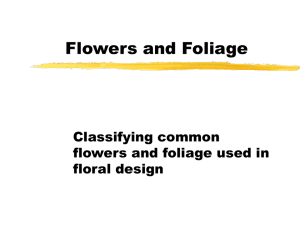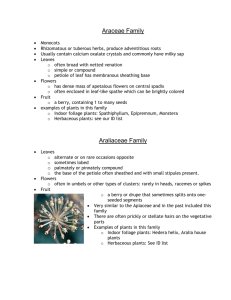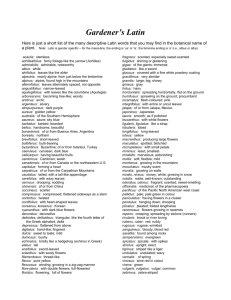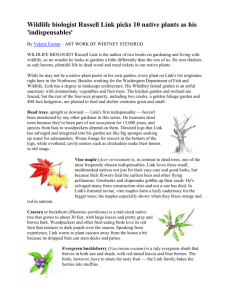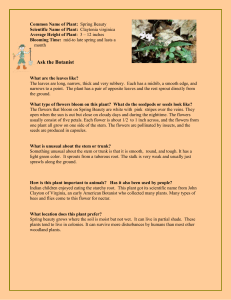SCREE GARDENING
advertisement
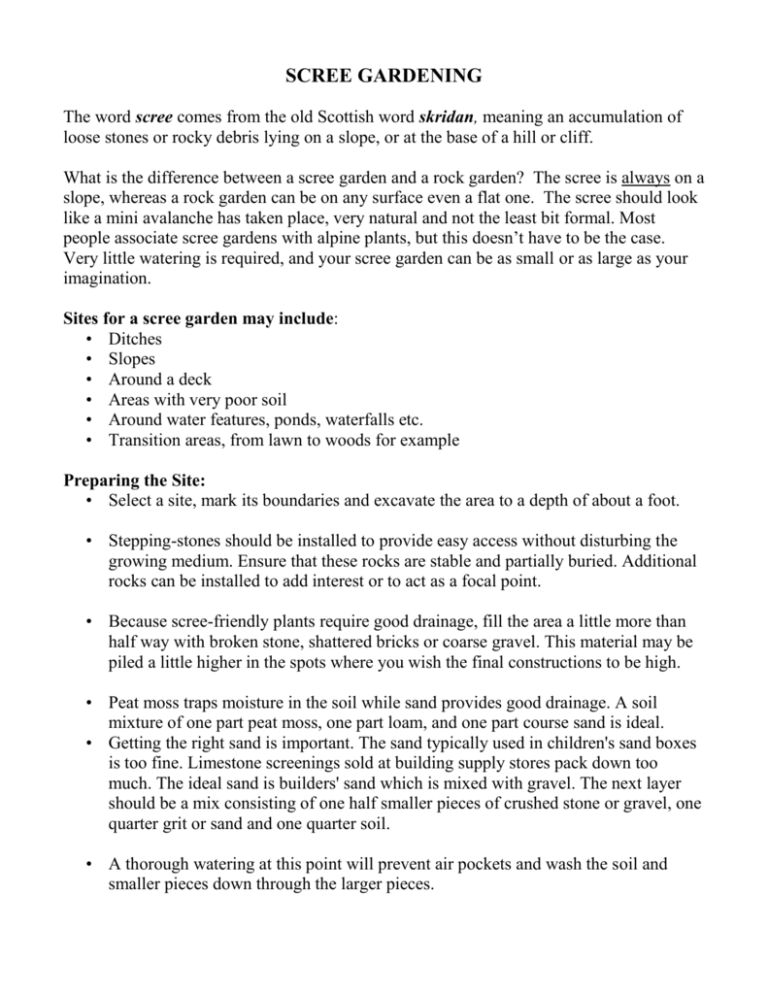
SCREE GARDENING The word scree comes from the old Scottish word skridan, meaning an accumulation of loose stones or rocky debris lying on a slope, or at the base of a hill or cliff. What is the difference between a scree garden and a rock garden? The scree is always on a slope, whereas a rock garden can be on any surface even a flat one. The scree should look like a mini avalanche has taken place, very natural and not the least bit formal. Most people associate scree gardens with alpine plants, but this doesn’t have to be the case. Very little watering is required, and your scree garden can be as small or as large as your imagination. Sites for a scree garden may include: • Ditches • Slopes • Around a deck • Areas with very poor soil • Around water features, ponds, waterfalls etc. • Transition areas, from lawn to woods for example Preparing the Site: • Select a site, mark its boundaries and excavate the area to a depth of about a foot. • Stepping-stones should be installed to provide easy access without disturbing the growing medium. Ensure that these rocks are stable and partially buried. Additional rocks can be installed to add interest or to act as a focal point. • Because scree-friendly plants require good drainage, fill the area a little more than half way with broken stone, shattered bricks or coarse gravel. This material may be piled a little higher in the spots where you wish the final constructions to be high. • Peat moss traps moisture in the soil while sand provides good drainage. A soil mixture of one part peat moss, one part loam, and one part course sand is ideal. • Getting the right sand is important. The sand typically used in children's sand boxes is too fine. Limestone screenings sold at building supply stores pack down too much. The ideal sand is builders' sand which is mixed with gravel. The next layer should be a mix consisting of one half smaller pieces of crushed stone or gravel, one quarter grit or sand and one quarter soil. • A thorough watering at this point will prevent air pockets and wash the soil and smaller pieces down through the larger pieces. • After planting, a top dressing of a decorative stone can be added and replenished if desired, but is not necessary. Selecting the Plants: • Select plants carefully. Recognizing that most alpine plants will not grow in our climate, consider augmenting your plantings to include ground cover perennials, low shrubs and dwarf conifers to recreate a mountain moraine appearance. Be aware of light conditions and moisture requirements when choosing plants. Slow-growing specimens that take years to cover scree areas are desirable, as rampant species will get out of control. Consider the color of the foliage, shape of leaves, structure of the plant, and color and timing of bloom. • Choose plants that prefer well-drained soil. Sedums, which come in a variety of sizes and shapes, as well as bloom color and timing, are ideal plants with very low maintenance requirements. Hens and Chicks, Native Prickly Pear and Spurge are also good choices. • Include some evergreens for year-round color and structure. Creeping or dwarf varieties come in a range of colors and shapes. Small flowering shrubs could also be considered. • Dig a hole large enough to accommodate the root ball. Remove the plant from the pot and tease the roots from the ball. Place the new plant in the hole, spreading the roots and apply some bone meal. Replace the gravel, and then water well. Water on alternate days (particularly in hot, dry weather) until new growth starts to appear, then reduce watering to a weekly schedule for another month. Thereafter, very little water is required. Maintaining Your Scree Garden: There is little maintenance required for a scree garden: • Once a month or so you can check for weeds. • Water only in times of drought (after it is established). • A fertilizer may be needed once every 1-2 years. A very light application of 10-10-10 should suffice. • Periodically clear the rocks of old plant matter, leaves etc. • Sit back and relax – your work is done. Moira Miller, LCMGA 21 Ideal Low Maintenance Scree Garden Plants Requires full sun for most of the day watering Once established, these plants require little or no supplemental Requires at least 3 hours shade during the hottest part of the day Name Dwarf Yarrow Pinwheel Botanical Name Height Achillea kellereri 8" Aeonium haworthii 18" Aethionema 'Warley Rose' 6" These plants will tolerate some drought, but benefit from periodic watering Characteristics White flowers and silvery foliage Sulfer Flower Eriogonum umbellatum Medium sized succulent that form rosettes of waxy blue-grey rosettes tinged in red Coral Bells Heuchera sanguinea Low growing, spreading mat of 1" green leaves; clusters of bright yellow flowers Glossy, 3 inch, deeply lobed green to purple 12"-18" leaves; clusters of scarlet flowers on a stout 15" stems in early-mid Spring 9"12" Light Water needs vary needs vary 5 to 10 Low growing shrubby evergreen, with long lasting bright rose-pink flowers Mossy looking mat of foliage with small 1" white 6" Sandwort Arenaria montana flowers Forms mound of dark green leaves; dense cover of Sea Pink Armeria maritima 4"-8" white to pink flowers in spring to summer Delosperma Shrubby succulent; bright Daisy-like magenta 5" Ice Plant cooperi flowers in mid to late Summer Mat of dark green, Oak-like leaves; 1 1/2 inch Mountain Dryas drummondii 4" white flowers in early Summer Avens Succulent blue-green clustering rosettes; bell Hens and Echeveria elegans & 2"-3" shaped pink flowers in late summer Sempervivum Chicks Stonecress Zone 6 to 11 6 to 9 4 to 9 4 to 9 6 to 11 2 to 9 4 to 9 6 to 9 6 to 10 Lewisia Lewisia tweedyi Lithodora Lithodora diffusa 8"-12" 4"-12" Oregano Origanum amanum 6"-8" Penstemon Penstemon pinifolius Pasque Flower Pulsatilla vulgaris Soapwort Saponaria ocymoides 4" Saxifraga bronchialis 8" Saxifrage Stonecrop Sedum acre 6" 8"-10" 1 1/2"2" Snowbell Soldanella alpina 6" Woolley Thyme Thymus Pseudolanuginosus 1” Rosettes of fleshy 4" evergreen leaves; satiny peach-pink flowers from Spring to Summer; requires perfect drainage Evergreen mini-shrub; bright blue, star shaped flowers in early Spring Evergreen, small heart shaped green leaves; funnel shaped pink flowers mid-summer Dark orange flowers, needle-like foliage; blooms June to September 3 inch, pale purple flowers are followed by ferny foliage and then by attractive silky seed heads Forms thick mat of ground covering, fine foliage; hundreds of small pink to red flowers cover the plant in early Spring Forms a cushion of moss-like, fine foliage; cream colored flowers, spotted with red or pink in late Spring Creeping, small bright green leaves covered with small, star shaped, golden flowers in Spring Clump forming, rounded leathery leaves; pale purple, fringed bells appear in early Spring Spreading mat of tiny, hairy, light green foliage; covered by tiny pink flowers in mid Summer. Several aromatic Thymes are also available. 5 to 9 6 to 10 6 to 10 6 – 11 5 to 9 4 to 10 4 to 9 5 to 10 5 to 9 3 to 9
